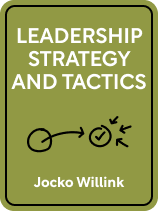

This article is an excerpt from the Shortform book guide to "Leadership Strategy and Tactics" by Jocko Willink. Shortform has the world's best summaries and analyses of books you should be reading.
Like this article? Sign up for a free trial here.
Want an overview of Leadership Strategy and Tactics by Jocko Willink? What are the qualities of the best leaders?
In Leadership Strategy and Tactics, Jocko Willink says if you want to be a good leader, you have to put your team before yourself. In the book, he explains exactly how to do this by learning to practice humility, build good relationships, and take responsibility for your team’s mistakes.
Read on for an overview of Jocko Willink’s Leadership Strategy and Tactics book.
Willink’s Leadership Strategy and Tactics
In Leadership Strategy and Tactics, Jocko Willink claims you can help your team become more successful and reach common goals by being humble, building good relationships, and taking responsibility for your team’s mistakes. What makes a great leader, he says, is learning to put others before yourself.
After serving for 20 years as a U.S. Navy SEAL, Willink developed a unique leadership philosophy that he shares through his leadership consulting program, Echelon Front, in books like Extreme Ownership (2015) and The Dichotomy of Leadership (2018), and through his podcast. In Leadership Strategy and Tactics (2020), Willink combines the leadership principles discussed in his previous books into a field manual, where he provides specific situational advice about how to lead well in your daily life.
The Importance of Leadership
First, we’ll discuss Jocko Willink’s idea of leadership in Leadership Strategy and Tactics to establish what this term means throughout this article and why it’s worth considering. We’ll start by distinguishing it from manipulation, then we’ll explain why leadership is essential for success.
What Is Leadership?
According to Willink, leadership is the ability to get people to support each other to achieve a common goal. He explains that leadership fundamentally involves getting people to do what you want them to do—when what you want them to do serves the common interest. Although this sounds similar to manipulation, Willink claims that these two strategies have different purposes. If you’re manipulating people, you’re simply controlling others to serve your own benefit. Manipulation might secure temporary success, but your team will eventually recognize your self-interested motivation and stop following you.
In contrast, Willink claims true leadership is motivated by the good of the people you’re leading and a goal you all share. If you lead to benefit your team and achieve a common mission, your team will recognize this and follow you.
| Is Manipulation Ever Ethical? Although Willink asserts that manipulation is separate from leadership, one expert claims that multiple philosophies would accept manipulation as an ethical leadership strategy. This implies that manipulation and leadership can coexist. Similar to Willink’s belief, Kantian philosophy would view manipulation as an ethical leadership strategy as long as you aren’t using someone merely as a means for your personal gain but instead are manipulating them in a way that respects their own interests. This is because Kantian philosophy views something as ethical if it treats someone as an “end in themselves” rather than “a means to an end.” And according to utilitarian philosophy, manipulating your team would be ethical as long as it helps more people than it harms. This is because Utilitarian philosophy prioritizes results over process and the greater good over individual happiness. |
Good Leaders Are Humble
When you’re in a leadership position, don’t ever consider yourself above your team. Doing this could cause your team to resent you and, as a result, they won’t follow you with much enthusiasm. Instead, work alongside your team with humility. In Leadership Strategy and Tactics, Jocko Willink says if you demonstrate humility, you’ll influence your team to cooperate with you to achieve a common goal. This is because acting humbly will earn you respect, and when people respect you, they follow you.
(Shortform note: Willink proposes that you can earn your team’s respect by displaying humility. A slight nuance, research suggests that showing humility influences your team to trust you, but only if they suspect your motivations are honest and well-intended. For example, if your team suspects you’re acting humbly solely because you want them to think highly of you, the plan could backfire.)
Practicing humility as a leader not only earns your team’s respect, but it enables you to better listen to your team. If you’re too prideful to accept criticism from others or to budge from your own ideas, you’ll waste time arguing with your team and you’ll miss out on ideas that are better suited to handle a situation. Additionally, if you resist advice from people with valuable experience and insight, you won’t be as informed as you could be, and the quality of your decisions will suffer. Instead, humility opens you up to helpful information so that you can make better leadership decisions. In this section, we’ll explore three ways to accept criticism with humility.
Good Leaders Build Relationships With Their Team
Once you’ve earned your team’s respect by practicing humility, you can build strong relationships. According to Willink, your team is held together by relationships, and relationships are built on trust. Without relationships, you simply won’t have a team to lead. To build good relationships with people, Willink says you have to extend trust to your team by empowering them to lead, by communicating regularly, and by always telling the truth.
(Shortform note: How do good relationships improve your team? Research shows that good relationships improve your team by increasing everyone’s creativity, collaboration, and productivity. Additionally, people who feel they have good relationships with work colleagues feel more satisfied with their jobs, are less likely to experience burnout, and are more likely to stay with their team long-term.)
Empower Your Team to Lead
Let your team know what needs to be done and why it matters to your shared mission, then give them freedom to decide how to do it. In Leadership Strategy and Tactics, Jocko Willink claims that by trusting your team with opportunities to lead, you’ll inspire them to reciprocate and trust you. For example, let’s say you give your team the responsibility of organizing a client event. Tell your team that you want to make your guests feel welcome and proud to be working with your company (this is what needs to be done). Then, explain why this is important: These clients are major partners with your organization and provide significant funds to grow the company. From there, let your team come up with the plan, or the how.
Communicate Regularly With Your Team
In addition to empowerment, good relationships are also fostered by effective communication. If communication is poor or lacking altogether, teams don’t understand the big picture or how their individual roles relate to the team’s mission. As a result, your team’s morale drops and the group risks falling apart. So, regular, quality communication is necessary to keep a team synced, healthy, and strong.
Have Conversations With Your Team
It sounds simple but is often overlooked: By regularly talking to your team members, you’ll get to know their perspectives better. Understanding each other’s points of view will further strengthen trust among your team. Here are a few tips for connecting with people on your team through conversation:
Get to know your team’s roles and responsibilities. Have them take you through their tasks. Ask them what does and doesn’t work for them so you can understand their daily life and improve any flaws in your team’s operation.
(Shortform note: It can also be beneficial to have your team members teach you something unrelated to their professional role. Connecting over a more casual subject can be a great way to bond. Additionally, you could arrange occasional workshops (in-person or virtual) where someone on your team hosts a meeting to teach something they’re passionate about. This way, you not only bond with that one team individual, but your whole team gets to know each other better.)
Validate other team members’ emotions and opinions. If you’re talking with someone who’s emotional about something, match their emotion first, then bring the intensity down as you ask questions and try to solve the problem. Matching their emotion will make the other person feel like you’re on their side. When people have opinions that don’t align with the team’s mission, empathize with their idea, then ask questions to understand the reason for their opinion. By understanding their ideas, Willink claims you’ll be able to counter and convince them to support your team’s goals more effectively.
(Shortform note: If someone’s negative thoughts or emotions are wearing on you or taking a lot of your time, experts say it’s important to set boundaries. This could mean establishing times during the day when you’re available to talk or limiting the majority of your interactions to email exchanges.)
Tell Your Team the Truth
Another way to maintain good relationships with your team is to always tell the truth. While it’s easy to deliver positive truths to your team, if you don’t communicate harsh truths, problems that might be easily solved with the support of your team will be harder to correct. If your team’s not aware of a problem, they can’t help you overcome it.
(Shortform note: Telling the truth isn’t just beneficial for the success of your team; it also supports good health. One study found that when participants consciously tried not to lie for 10 weeks, they reported significantly fewer negative mental and physical health symptoms than those who didn’t avoid lying.)
Additionally, if you try to hide the negative side of a situation, your team will eventually find out on their own, which can cause them to lose their trust in you or even spread harmful rumors about why it’s happening. When people aren’t told what’s going on, they speculate about why bad things are occurring. In Leadership Strategy and Tactics, Jocko Willink says that speculations made in the dark are always worse than the reality. These negative ideas are harmful because they can turn into self-fulfilling prophecies. For example, if your team believes your company is going to fail, they might start working carelessly because they believe the company is going under anyway. As a result, the company suffers even more and eventually fails.
(Shortform note: Although transparency can prevent many problems, there are certain cases where transparency could do more harm than good. In Principles, Ray Dalio argues that information is best kept quiet when it involves personal issues, when it could put the long-term interests of your team or your clients at risk, or when sharing information is likely to be more distracting than beneficial to their performance.)
Good Leaders Take Responsibility for Their Team’s Problems
According to Willink, as a leader, you’re responsible for any problems that occur on your team. Casting blame when something goes wrong wastes time and causes your team to stagnate. Instead, embrace the responsibility you have for your team’s problems and focus on creating solutions.
Benefits of Radical Responsibility
Willink coined the phrase “extreme ownership” and even titled a book after it. In this section, we’ll explore what this means, referring to it as “radical responsibility.” Radical responsibility means taking responsibility for all of the problems related to your team and mission. A mindset of radical responsibility not only puts you in a position to solve whatever problems are at hand, but it also helps prevent future issues. If you know that you’ll bear the weight of responsibility for any of your team’s potential missteps, you’ll take preemptive actions to avoid mistakes.
Another benefit of taking responsibility is that it’s contagious. By taking responsibility for a problem, you’ll inspire other people to take responsibility, too.
Exercise: Strengthen Your Leadership
In Leadership Strategy and Tactics, Jocko Willink stresses the importance of humility, good relationships, and taking responsibility. Think about how you can do these things right.
- Think of a time when a leader of yours didn’t show humility and it hurt morale. What happened? How did you or your teammates respond?
- Consider how Willink’s advice about humility could have made a positive difference in this situation. If you were in this person’s place, how might you handle it, knowing what you know now? (For example, could you use less condescending language or listen more openly to your team?)
- Next, reflect on the relationships that were at play. Was the person communicating clearly with the people on your team? As a leader, how would you prevent miscommunications?
- Finally, was there any blaming that held up your team’s progress toward solutions? How do you think your team would have responded if the leader accepted responsibility for every aspect of the issue?

———End of Preview———
Like what you just read? Read the rest of the world's best book summary and analysis of Jocko Willink's "Leadership Strategy and Tactics" at Shortform.
Here's what you'll find in our full Leadership Strategy and Tactics summary:
- A former US Navy SEAL's advice on how to be a good leader
- Three ways you can practice humility and earn your team’s respect
- Why you must always tell the truth, even when it's harsh






